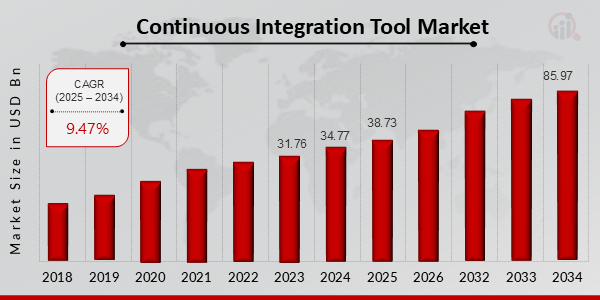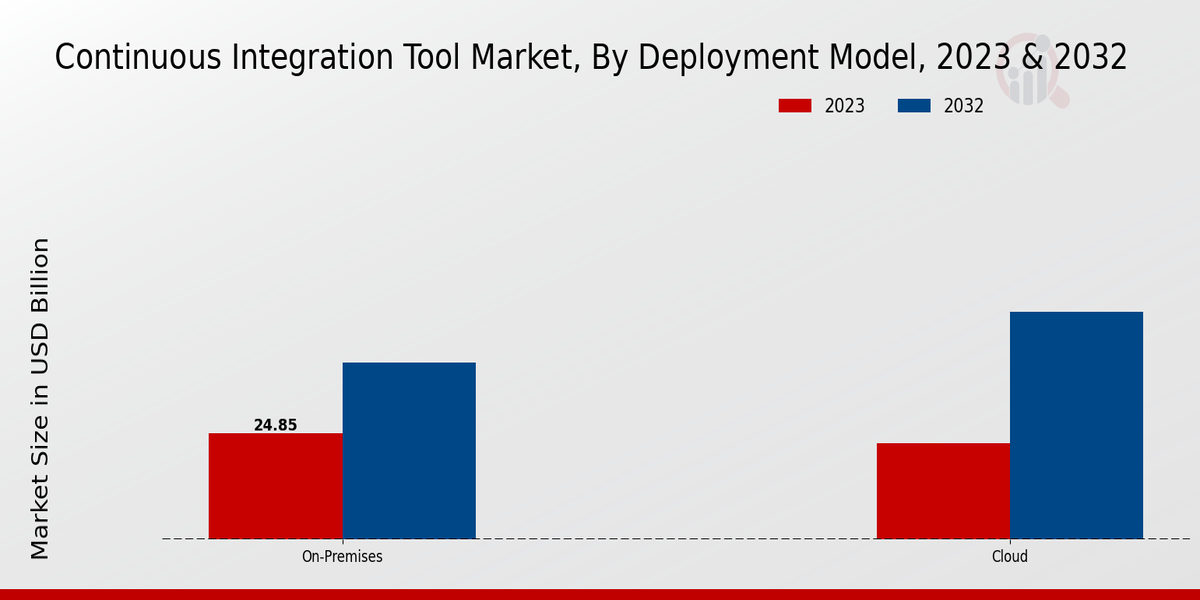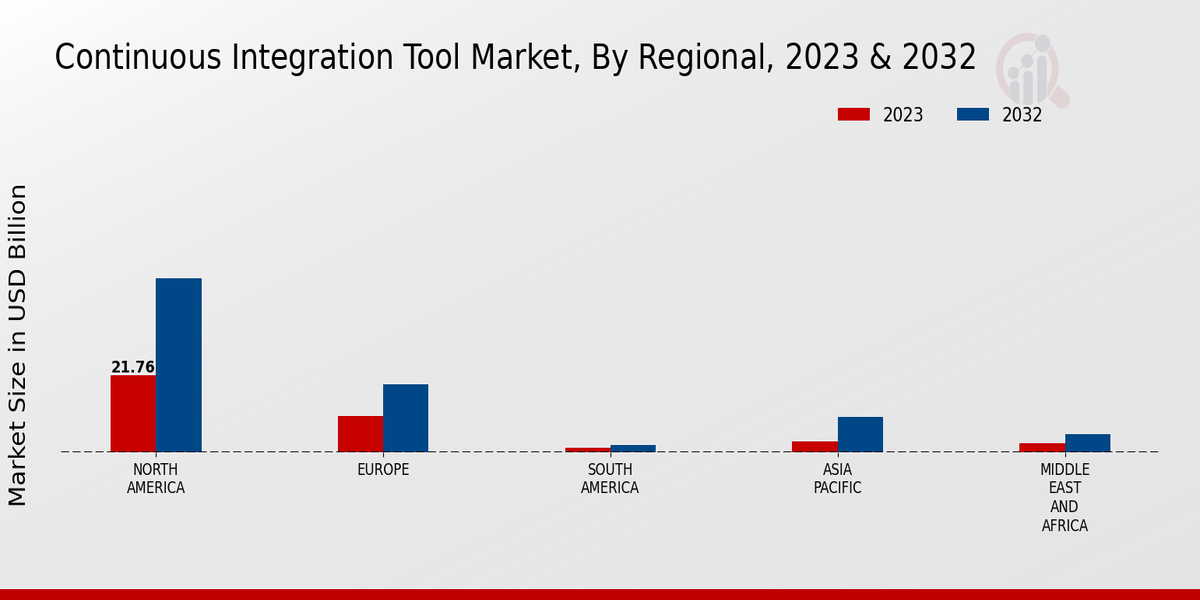Continuous Integration Tool Market Overview
Continuous Integration Tool Market is projected to grow from USD 38.73 Billion in 2025 to USD 85.97 Billion by 2034, exhibiting a compound annual growth rate (CAGR) of 9.47% during the forecast period (2025 - 2034). Additionally, the market size for Continuous Integration Tool Market was valued at USD 34.77 billion in 2024.
Figure1: Continuous Integration Tool Market, 2025 - 2034
Source Primary Research, Secondary Research, MRFR Database and Analyst Review
Key Continuous Integration Tool Market Trends Highlighted
The Continuous Integration Tool market is witnessing a surge in demand, driven by the crescente need for automated and streamlined software development processes. The rising popularity of DevOps methodologies and the shift towards agile development practices are key market drivers. Additionally, the growing adoption of cloud-based CI/CD tools is expanding market opportunities. Recent trends include the emergence of AI and ML-powered CI tools, enabling enhanced automation and improved code quality. The integration of security testing and compliance capabilities into CI tools is also gaining traction. Moreover, the increasing demand for open-source CI tools and the growing adoption of container-based technologies are shaping market dynamics. To capture these opportunities, market players are focused on developing innovative solutions that cater to evolving industry needs. The integration of AI/ML, enhanced security features, and support for multi-cloud environments are expected to drive market growth in the coming years.
Continuous Integration Tool Market Drivers
Shift towards Agile and DevOps Methodologies
The increasing adoption of agile and DevOps methodologies in software development is a key driver of the Continuous Integration Tool Market Industry. These methodologies emphasize collaboration, automation, and continuous improvement, and continuous integration tools play a crucial role in enabling these practices. By automating the build, test, and integration processes, continuous integration tools help development teams to deliver high-quality software faster and more efficiently. Furthermore, the rise of cloud computing and the proliferation of microservices-based architectures are further driving the demand for continuous integration tools, as these environments require more frequent and automated software updates.
Growing Need for Continuous Delivery and Deployment
The growing demand for continuous delivery and deployment (CD/CD) practices is another major factor driving the growth of the Continuous Integration Tool Market Industry. CD/CD practices enable development teams to deliver software updates to production more frequently and with less risk. Continuous integration tools play a critical role in supporting CD/CD pipelines by automating the build, test, and deployment processes. By enabling faster and more reliable software delivery, continuous integration tools help businesses to accelerate innovation, improve customer satisfaction, and gain a competitive advantage.
Increasing Regulatory Compliance Requirements
Stringent regulatory compliance requirements in various industries, such as healthcare, financial services, and automotive, are also driving the demand for continuous integration tools. These regulations require businesses to implement robust software development processes and maintain a high level of software quality. Continuous integration tools help businesses to automate compliance checks and ensure that software meets all regulatory requirements. By providing a centralized platform for managing compliance-related tasks, continuous integration tools help businesses to reduce the risk of non-compliance and streamline their software development processes.
Continuous Integration Tool Market Segment Insights
Continuous Integration Tool Market Deployment Model Insights
The Continuous Integration Tool Market segmentation by Deployment Model is into On-Premises and Cloud. The Cloud segment is expected to grow at a faster rate during the forecast period, owing to the increasing adoption of cloud-based solutions by enterprises of all sizes. The Cloud deployment model offers several advantages over the On-Premises model, including lower upfront costs, increased flexibility, and scalability, and reduced maintenance and support costs. The On-Premises segment accounted for the larger share of the Continuous Integration Tool Market in 2023.
However, the Cloud segment is expected to grow at a faster CAGR during the forecast period. The market growth is attributed to factors such as the increasing adoption of agile development methodologies, the growing need for automated testing and continuous delivery, and the increasing awareness of the benefits of Continuous Integration tools. Some of the key players in the Continuous Integration Tool Market include Jenkins, Atlassian, CircleCI, Travis CI, and GitLab. These players offer a wide range of Continuous Integration tools and solutions that cater to the needs of various enterprises.
Overall, the Continuous Integration Tool Market is expected to witness significant growth in the coming years, driven by the increasing adoption of agile development methodologies, the growing need for automated testing and continuous delivery, and the increasing awareness of the benefits of Continuous Integration tools.
Figure2: Continuous Integration Tool Market, By Product Type, 2023 & 2032
Source Primary Research, Secondary Research, MRFR Database and Analyst Review
Continuous Integration Tool Market Tool Type Insights
The Continuous Integration Tool Market is segmented by tool type into commercial and open source. The commercial segment is expected to hold a larger market share in 2023, due to the increasing adoption of commercial tools by large enterprises. Commercial tools offer a wider range of features and functionalities, as well as better support, compared to open-source tools. However, the open-source segment is expected to grow at a faster rate during the forecast period, due to the rising popularity of open-source software and the increasing adoption of DevOps practices. By 2032, the open-source segment is expected to account for a significant share of the Continuous Integration Tool Market revenue.
Continuous Integration Tool Market Application Insights
The Continuous Integration Tool Market is segmented by Application into Web Development, Mobile Development, Infrastructure Management, and DevOps. The Web Development segment held the largest market share in 2023 and is expected to continue to dominate the market throughout the forecast period. The growing adoption of agile development methodologies and the increasing need for continuous delivery and integration are driving the growth of this segment. The Mobile Development segment is also expected to witness significant growth over the forecast period due to the increasing popularity of mobile applications and the need for continuous integration and delivery in mobile app development.
The Infrastructure Management segment is expected to grow steadily due to the increasing adoption of cloud computing and the need for continuous integration and delivery in infrastructure management. The DevOps segment is also expected to grow significantly due to the increasing adoption of DevOps practices and the need for continuous integration and delivery in DevOps environments.
Continuous Integration Tool Market Team Size Insights
The Continuous Integration Tool Market is segmented by Team Size into Small Teams, Mid-Size Teams, and Large Enterprises. Small Teams held the largest market share in 2023, accounting for approximately 40% of the Continuous Integration Tool Market revenue. This is due to the increasing adoption of agile development methodologies and the need for efficient and automated CI/CD pipelines by small development teams. Mid-Size Teams are expected to witness the highest growth rate during the forecast period, owing to the growing adoption of CI/CD tools by mid-sized organizations to improve software quality and reduce time-to-market.
Large Enterprises are also expected to contribute significantly to the Continuous Integration Tool Market growth, as they invest heavily in CI/CD tools to streamline their software development processes and improve collaboration among large development teams.
Continuous Integration Tool Market Integration Capabilities Insights
The integration capabilities segment of the Continuous Integration Tool Market is expected to witness significant growth in the coming years, driven by the increasing adoption of DevOps practices and the need for efficient and automated software development processes. The Version Control Integration sub-segment is anticipated to hold a major market share, owing to the growing popularity of version control systems such as Git and Subversion. The Issue Tracking Integration sub-segment is also projected to experience substantial growth, as organizations seek to streamline their issue tracking and resolution processes.
Build Automation and Deployment Automation are other key sub-segments that are expected to contribute to the overall market growth, as they enable developers to automate the software build and deployment processes, leading to increased efficiency and reduced time-to-market.
Continuous Integration Tool Market Regional Insights
The Continuous Integration Tool Market is segmented into North America, Europe, APAC, South America, and MEA. North America is expected to hold the largest market share in 2023, owing to the presence of major players and early adoption of advanced technologies. APAC is projected to be the fastest-growing region, driven by increasing demand from developing economies such as China and India. Europe is expected to witness steady growth due to government initiatives and increasing awareness of DevOps practices. South America and MEA are expected to show moderate growth due to limited infrastructure and skilled workforce.
Figure3: Continuous Integration Tool Market, By Regional, 2023 & 2032
Source Primary Research, Secondary Research, MRFR Database and Analyst Review
Continuous Integration Tool Market Key Players And Competitive Insights
Major players in the Continuous Integration Tool Market are competing fiercely to maintain their market share and position in the industry. Leading Continuous Integration Tool Market players are continuously innovating and developing new features to stay ahead in the competition and meet the evolving needs of their customers. The Continuous Integration Tool Market is expected to witness significant development in the coming years as the increasing adoption of cloud-based technologies and the growing demand for automation drive market growth. Continuous Integration Tool Market industry is expected to be highly competitive, with a number of established and emerging players vying for market share.
One of the leading players in the Continuous Integration Tool Market is Jenkins. Jenkins is an open-source, continuous integration tool that can be used to automate the software development process. Jenkins is highly customizable and can be integrated with a variety of other tools, making it a popular choice for development teams of all sizes.
Another major player in the Continuous Integration Tool Market is CircleCI. CircleCI is a cloud-based continuous integration tool that provides a range of features to help teams build, test, and deploy their software. CircleCI is known for its ease of use and its ability to scale to meet the needs of large development teams.
Key Companies in the Continuous Integration Tool Market Include
-
Harness
-
GitLab
-
GoCD
-
Bamboo
-
Nevercode
-
Jenkins
-
CloudBees CI
-
Buddy
-
TeamCity
-
Azure DevOps
-
CodeShip
-
Travis CI
-
Semaphore
-
CircleCI
-
AWS CodePipeline
Continuous Integration Tool Market Industry Developments
The Continuous Integration Tool Market is projected to grow significantly in the coming years, driven by the increasing adoption of DevOps and Agile methodologies. Key market players include Jenkins, Travis CI, CircleCI, and GitLab. In 2023, the market size was valued at USD 29.02 billion and is expected to reach USD 65.5 billion by 2032, exhibiting a CAGR of 9.47%. The market is witnessing the emergence of several trends, including the adoption of cloud-based CI tools, the integration of AI and ML, and the rise of low-code/no-code solutions. Recent news developments include the acquisition of CircleCI by Ericsson and the launch of new features by Jenkins and Travis CI. Overall, the market is poised for robust growth, driven by the increasing demand for automation and efficiency in software development.
Continuous Integration Tool Market Segmentation Insights
Continuous Integration Tool Market Deployment Model Outlook
Continuous Integration Tool Market Tool Type Outlook
Continuous Integration Tool Market Application Outlook
- Web Development
- Mobile Development
- Infrastructure Management
- DevOps
Continuous Integration Tool Market Team Size Outlook
- Small Teams
- Mid-Size Teams
- Large Enterprises
Continuous Integration Tool Market Integration Capabilities Outlook
- Version Control Integration
- Issue Tracking Integration
- Build Automation
- Deployment Automation
Continuous Integration Tool Market Regional Outlook
- North America
- Europe
- South America
- Asia Pacific
- Middle East and Africa
|
Report Attribute/Metric
|
Details
|
|
Market Size 2024
|
34.77 (USD Billion)
|
|
Market Size 2025
|
38.73 (USD Billion)
|
|
Market Size 2034
|
85.97 (USD Billion)
|
|
Compound Annual Growth Rate (CAGR)
|
9.47% (2025 - 2034)
|
|
Report Coverage
|
Revenue Forecast, Competitive Landscape, Growth Factors, and Trends
|
|
Base Year
|
2024
|
|
Market Forecast Period
|
2025 - 2034
|
|
Historical Data
|
2019 - 2023
|
|
Market Forecast Units
|
USD Billion
|
| Key Companies Profiled |
Harness, GitLab, GoCD, Bamboo, Nevercode, Jenkins, CloudBees CI, Buddy, TeamCity, Azure DevOps, CodeShip, Travis CI, Semaphore, CircleCI, AWS CodePipeline |
| Segments Covered |
Deployment Model, Tool Type, Application, Team Size, Integration Capabilities, Regional |
| Key Market Opportunities |
Increased DevOps Adoption Growing Need for Automated Software Delivery Cloud Based Deployment Adoption in Agile Development Enterprise Focus |
| Key Market Dynamics |
Rising demand for DevOps Increasing adoption of cloud based CICD tools Growing need for automation Security concerns Skills gap |
| Countries Covered |
North America, Europe, APAC, South America, MEA |
Frequently Asked Questions (FAQ) :
The Continuous Integration Tool Market is expected to reach USD 85.97 billion by 2034, exhibiting a CAGR of 9.47% from 2025 to 2034.
North America is anticipated to dominate the Continuous Integration Tool Market with a significant market share throughout the forecast period.
The IT and telecom sector is projected to be the major end-user of Continuous Integration Tools, contributing substantially to market growth.
Key players in the Continuous Integration Tool Market include Jenkins, CircleCI, TeamCity, Bamboo, and Azure DevOps Server, among others.
Continuous Integration Tools are primarily used for continuous software delivery, version control, automated testing, and code collaboration.
The rising demand for DevOps practices, the need for faster software delivery, and the increasing adoption of cloud-based tools are driving the growth of the Continuous Integration Tool Market.
Security concerns, integration complexities, and the availability of open-source alternatives pose challenges to the growth of the Continuous Integration Tool Market.
Growing adoption in emerging economies, advancements in AI and ML, and the increasing demand for low-code/no-code solutions present growth opportunities for the Continuous Integration Tool Market.
The COVID-19 pandemic has accelerated the adoption of Continuous Integration Tools due to the increased need for remote collaboration and agile software development.
Factors such as improved software quality, faster release cycles, and enhanced collaboration among development teams drive the adoption of Continuous Integration Tools.

















